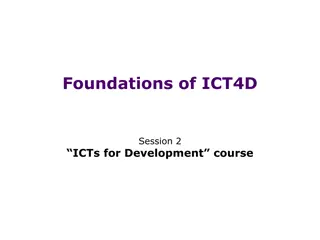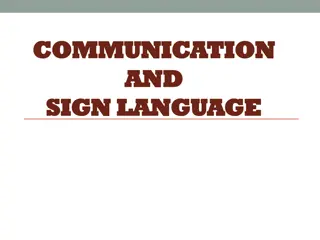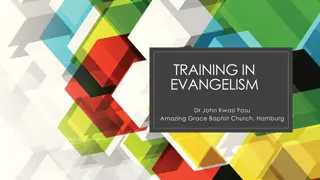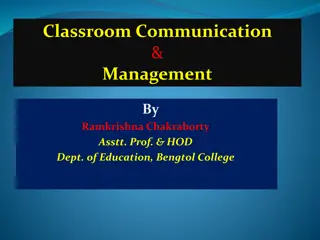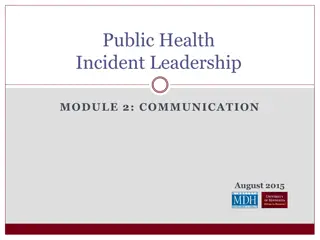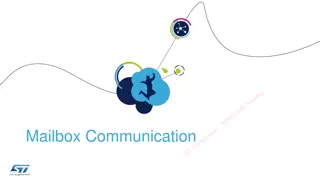Communication foundations
Explore strategies to support children's speech, language, and communication development. Learn the importance of communication in interactions, the role of different professionals, and practical tips such as getting face-to-face with your child. Discover how to create a supportive environment for communication growth and build essential skills.
Download Presentation

Please find below an Image/Link to download the presentation.
The content on the website is provided AS IS for your information and personal use only. It may not be sold, licensed, or shared on other websites without obtaining consent from the author.If you encounter any issues during the download, it is possible that the publisher has removed the file from their server.
You are allowed to download the files provided on this website for personal or commercial use, subject to the condition that they are used lawfully. All files are the property of their respective owners.
The content on the website is provided AS IS for your information and personal use only. It may not be sold, licensed, or shared on other websites without obtaining consent from the author.
E N D
Presentation Transcript
Communication foundations Speech and Language Therapy CYPIT
Disclaimer The purpose of the session today is to provide you with information on strategies which can be used with your child to support the development of their speech, language and communication skills. By attending this webinar, you are not referring your child to the Speech and Language Therapy service. You are welcome to use the Q&A function to ask questions. Given that this is a TEAMs webinar and is not designed to provide specific clinical intervention, any identifiable information you provide about your child will not be processed or retained. Should you provide information regarding your child, we will not use this unless there is an identified safeguarding concern. My colleague is monitoring messages being sent to us to identify questions which require a response. Messages with identifiable information will not be published. If this is the case, data will be used to escalate appropriately to the safeguarding team
Circles of support/ influence General Practitioner Occupational Therapist Nursery staff f Family Working together: The people who will be able to make the most change are those closest to the child Child Respite Keyworker SEND Team Falvey, M. A., Forest, M., Pearpoint, J., & Rosenberg, R. L. (1997) Speech and Language Therapist Dietitian Physiotherapist
Speech, language and communication Speech is the ability to combine sounds into words. Language is talking (expressive) and understanding (receptive). Communication is how we interact with others.
Communication Tree Leaves and blossom Your child pronounces all their letters/sounds properly Branches Your child says lots of different words and uses sentences Environment For communication to grow, children need those around them to: Trunk Your child understands what you are saying Use language at the right level Use the language the adult is most comfortable speaking. Enjoyment of being with someone Understanding that communication can influence a person Roots Listening Play Desire to communicate Turn-taking Attention control
Strategy 1: Get face-to-face To gain your child s attention, you may need to call their name whilst: Getting down to their level Entering their eye line Imitating their play and sounds Using tactile cues
There is no app to replace your lap!
Strategy 2: Observe Tune in to your child and take notice of what they are interested in You can choose how you respond. Showing interest in what they enjoy doing will build positive social interactions
Strategy 3: Intensive interaction This helps your child to interact with the world around them, whilst they remain in control Notice what your child is doing 1. Allow your child to control the interaction 2. Imitate your child and join in 3. Respondto your child s interests enthusiastically 4.
Strategy 4: Ready, steady, go! Any type of game where the aim of the game is to do a single simple action. Building/knocking down a tower Before doing the action, someone says Ready, Steady, Go . Blowing bubbles Rolling a ball Running Skittles Once Go has been said, the action is performed. Playing music Balloons Pushing a car Jumping
Consider this: What makes you want to communicate?
Motivators to communicate To request To ask for help To reject To share how we feel To chat and share To joke To learn
Means, reasons and opportunities For a child to communicate, they need the three following things: Means Means Does the child have a reliable method of communication that they know how to use? Opportunities Does the child have an opportunity to use their communication skills? Functional communication Reasons Opportunity Reasons Does this child have an irresistible reason to communicate with you?
Strategy 5: Creating opportunities Sabotaging is setting up situations/problems so that a child needs to communicate with you to get what they want 1. Identify what s motivating to your child 2. Give your child a reason to communicate by sabotaging! 3. Then pause for your child to notice 4. Provide the opportunity for communication by waiting 5. Respond immediately
Strategy 5: Creating opportunities Give them their food without cutlery, or with the wrong cutlery Give your child food in packaging they can t open, or put a favourite item in a transparent, hard-to-open container Give them the iPad/phone without entering the passcode Give them a marble run without the marbles, or set up a race track, but don t provide cars Put their favourite toy on a high shelf, out of reach Give them a battery- operated toy without the batteries, or give them a wind-up toy without winding it up first
Strategy 6: Giving choices Support the two choices visually with the object, picture or sign Start with a motivating and less motivating item when making choices Examples: do you want sweets or clothes? do you want juice or water? do you want cars or blocks?
Strategy 7: Simple language When talking to your child, use single key words to label what they are doing and/or are interested in Make sure words are functional and link with your child s interests Repeat and emphasise these words Keep it positive! Avoid questions
Strategy 8: Give clues To help your child understand and learn spoken language, use the following clues, while speaking: Natural gesture Real objects Pictures Context, e.g. offering dinner when in the kitchen Signing, e.g. Makaton Hand over hand support e.g. wash whilst putting your child s hands under the tap
To recap: 1. Get face-to-face 2. Observe 3. Intensive interaction 4. Ready, steady, go! 5. Creating opportunities 6. Giving choices 7. Simple language 8. Give clues
Good relationshipslead to good communication Good communicationleads to good relationships
Language takes time to develop To see progress, these strategies need to be used daily
Thank you for listening Further help can be found via our website: cypf.berkshirehealthcare.nhs.uk/communication






